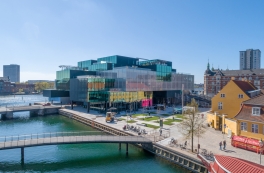

Room for Rain: New industrial PhD on urban climate adaptation
26.02.2019
Anna Aslaug Lund, landscape architect with Gottlieb Paludan Architects, defended her thesis ‘Room for Rain – the city as a garden and the future of streets’ on Monday 25 February and she was awarded her PhD. The thesis deals with the issues of handling increased quantities of water and how innovative solutions will enhance the quality of life in our cities by contributing to their architectural, sensory and recreational values. Anna Aslaug Lund completed this project as an Industrial PhD in collaboration with Gottlieb Paludan Architects, Rambøll and the University of Copenhagen.
Here you can read a short interview with Anna about the project:
Why did you choose to focus on the street as urban space in relation to the challenge of climate change adaptation?
The cloudburst plans in place for e.g. Copenhagen are based on what you might call landscape-based rainwater handling, meaning that as much of the water as possible is dealt with on the surface. In practical terms this means that our streets will function as important transport routes for cloudburst water. The central idea of the cloudburst plans is that the streets will delay the water, giving it the chance to infiltrate and in specific places creating the opportunity for the water to flow on the surface and subsequently to be directed to, for example, parks and watercourses. In other words, the cloudburst plans mean that many of our streets will change character in the near future. This is a consequence for the future of our streets which I believe is both very interesting and very important to discuss and explore as an architect; the fact is that seen from a social and purely physical perspective, our streets are environments that are central to urban existence in the sense that they are some of the urban spaces with which we are in most frequent contact on a day to day basis. In this way, the necessary climate change adaptation of the city provides us with a unique opportunity to develop the potential of the street as a social and sensory space in the urban environment.
How does your PhD project contribute to the future handling of cloudbursts in street spaces?
One of the objectives of the project was to widen the spectrum of possible solutions to designing street spaces that will be able to handle the increasing quantities of rainwater on the surface, while supporting social and sensory values and improving the conditions for natural ecosystems. You could say that the project produced three main results. The first result is that I explored how we could develop a language to talk about the street as a physically experienced space. As it is, we predominantly speak about streets in technical terms. Our language is inextricably linked to our practice and the physical expression that we give our projects. That is why I believe it is very important to have a language to talk about the things that streets can also be – namely important sensory and social spaces. The second result is that I developed a type of catalogue of what I call “spatial shapes”, exploring through drawing and photography the variety of possible solutions to how the cloudburst management initiatives that we implement in streets can also support the sensory and social values of the spaces. I like to think that these findings will be useful to architects and engineers during the drafting phase of a project. The last result is a method to produce site-specific cloudburst solutions.
You spent part of your PhD course at Columbia University in New York as a visiting researcher –what knowledge and experience did you gain from that?
In as much as Columbia University is an international hub where you meet scientists from all over the world, I was able to confirm that many of the same issues in relation to the challenges of climate change adaptation are being discussed in many different countries. This brought it home to me that the themes I have explored in my PhD thesis have clear international relevance. Denmark is one of the countries that are at the forefront of combining climate change adaptation with other initiatives, but we can also learn a great deal from studying what they do in other countries to counteract the impact of climate change.
What are your central recommendations to advisers, local authorities, utility companies and policy makers working with cloudburst management in cities?
I make various recommendations in my thesis, such as the importance of interdisciplinary collaboration and focusing on the natural cycles of the environment. However, a crucial point which I would like to emphasize here concerns awareness of site-specific solutions. Many initiatives to combat the impacts of climate change will involve transforming existing streets. It is crucial to the success and quality of these projects that they are manifestly sensitive to existing spatial qualities and are based on an accurate reading of, for example, existing social patterns. After all, the cloud burst solutions of the future will have to take account of a wide range of complex issues, ranging from kerbstone heights and accessibility, biodiversity, resource awareness and topography to cultural standards and power structures. I believe that it is absolutely essential that we retain the complexity of the initiatives we employ to protect our cities against cloudbursts.








